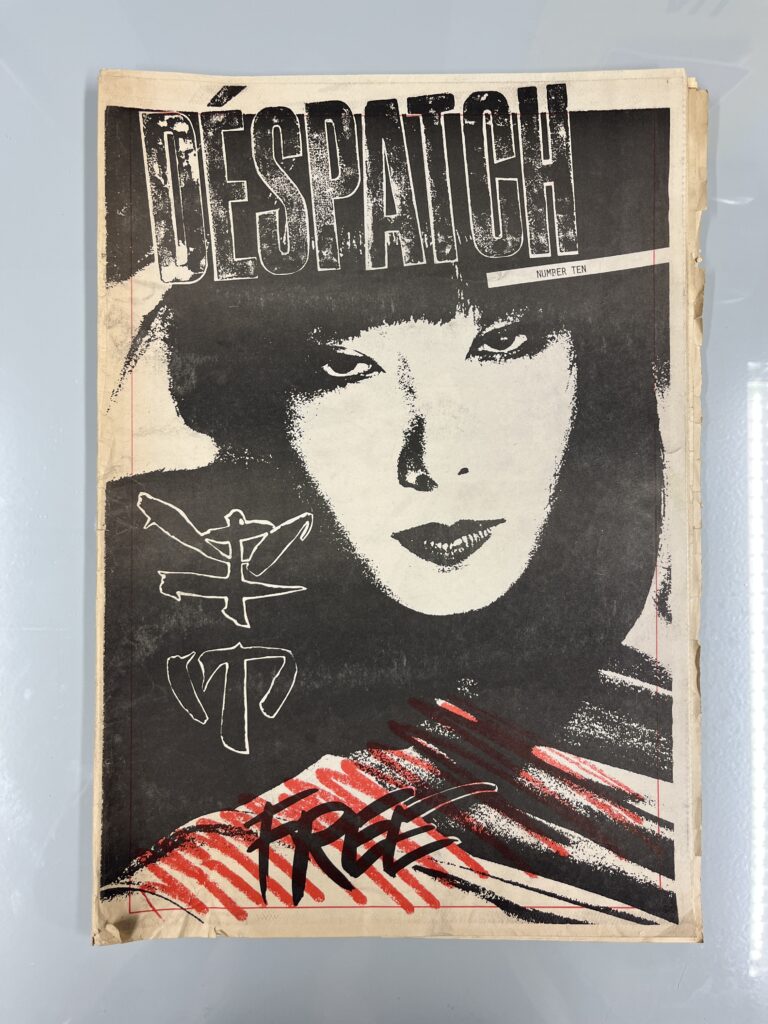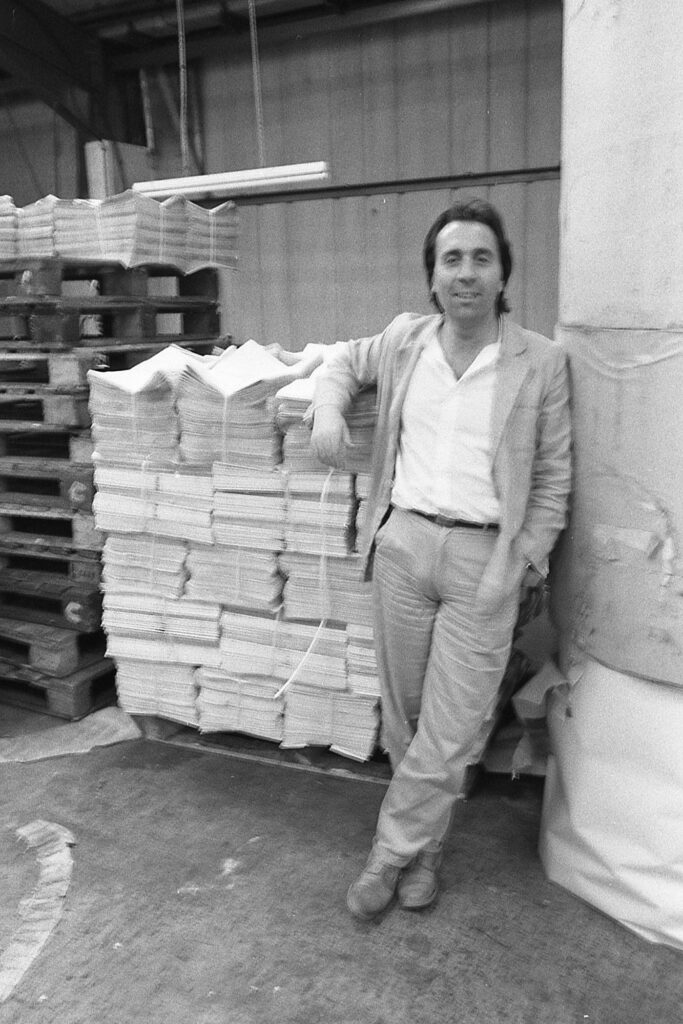Though not claiming the invention of fanzines, the punk scene certainly ‘took up arms’ and utilised them as an urgent and alternative form of disseminating infatuation, information, critique, invective and a general extra-musical ballast. Matthew Worley, in his 2024 book on fanzine cultures in the punk and post-punk era, has plotted and unpicked much of this autonomous and DIY phenomenon. It is vast and sprawling, reaching into the remotest crevices of UK punk life. In Derby we had numerous punk fanzines such as Situation Vacant and Jubilee City, whilst Nottingham had Y running from 1980 (with a debut issue as Death or Glory) which had a confident finger on the post-punk pulse and saw important music writers such as Matthew Collin start out.
The combining of music and fashion was generally a no-go area for punk and post-punk fanzines, with the trio of ‘proper’ magazines The Face, i-D and Blitz taking on a new market in this area through 1980 (even though i-D was maybe half a chromosome from being a fanzine). Then, in spring 1981, Nottingham and the East Midlands was suddenly presented with the broadsheet-format Déspatch. Markedly different from anything in the immediately preceding era, it was announced in The Face in June, with a column by regional correspondent Matthew Hyphen. Whether that was a real name, or an awkward post-punk nom-de-plume, I’m not sure, but the article had a typical preface that denigrated the possibility of anything so regional as Nottingham as having a scene that can stand up to the almighty London. It is worth quoting at length: “Nottingham’s scene has never been as sharply focused as its counterpart in the Capital. The general atmosphere of the place is too blatantly parochial and with Robin Hood and Brian Clough vying for position as Pride of the Midlands (not forgetting Paper Lace, of course!) it is a minor miracle if any creative endeavours flourish at all”. Nothing like a great build-up, is there?

Déspatch is said to be in the style of Ritz, a 70s fashion tabloid out of London, and available for 20p from the editorial office on St. James Street. The name Ron Atkinson is mentioned as the designer, who is also said to be the owner of Derby’s Blue Note (he wasn’t – he just did the re-fit). The first issue includes features on Duran Duran, Stray Cats (the band), new romantic dance troupe Shock (all of these presumably interviewed during Rock City appearances), the fashion designer Calvin Klein (prior to their famed underwear domination), and the graphic designer Eric Bell (who worked with Bowie). The rest of the newspaper reports from the after-dark scenes and provides a heavy serving of “local mini-celebrity gossip”.
With its strong design, utilisation of a cursive font, and a frequent dive into salacious tales of local faces and worse-for-wear mugshots of clubbers and posers, Déspatch is clearly modelled on Andy Warhol’s publication Interview. Founded in 1969 as a film critique newssheet, Interview quickly became an extension of Warhol’s documentation of the follies and foibles of fame. Déspatch had a similar mission, and I recall picking it up later in 1981, when it was free. It was a thrill to feast upon the mix of glamorous people – an east Midlands demi-monde – amidst adverts for swanky clothes shops. As I started to venture out to clubs like the Blue Note and Whispers I longed to be featured… but never was!
Ron Atkinson, the founder, was an important figure in Nottingham’s fashion, music and arts scenes. He also provides a bridge from the 60s and 70s into the new era of the 80s. Ron trained as a teacher at Clifton teacher training college in 1965, and was in local bands with Bernard Mitchell, Tony Taylor, Dave Martin, and Geoff Martin. With the addition of Stu Harrison, Ron and Bernard shared a house in the St. Ann’s area and began a sideline interest in graphic design called Egg Graphix. On Saturdays they would go to see Paul Smith and annoy him as he worked at Birdcage boutique on Bridlesmith Gate. Ron then followed his instincts and left teaching (he was a PE teacher) to start his own interior design and graphics business, settling on the name Ice Blue Studios.
As is well documented, Paul Smith also set up on his own and rented a basement on Byard Lane selling fashion. Though Paul had moved his efforts to London’s Floral Street in 1979, he remained a major force of benefaction and inspiration in Nottingham. His name ran through the city’s fashion endeavours like a stick of rock, supporting numerous fledgling fashion designers. Staff in his Nottingham shop would often go on to strike out with independent ventures, such as the setting up of Wild Clothing in 1983. He also gave Ron a leg-up, setting aside an area of his first shop as a book/photo sales and exhibition space, with Ron also key in the future design of Paul’s shops.

In running his own business and to build his client base in Nottingham and Derby, Ron mixed with the right movers and shakers. When Déspatch was conceived and launched Ron had a shop and studio on St. James Street. Bernard Mitchell has a great photograph of Ron picking up the first issue of Déspatch from the printers at Heanor, sporting his light suit. Ron was something of legend, and Déspatch had a chaotic undercurrent with an extensive cast list of contributors. His nickname of ‘Later Ron’ derived from instances of slipshod scheduling, such as a Christmas feature of key Nottingham clothing retailers dressed as Santa appearing in an edition that went out closer to Easter.
Ron’s connection to the Blue Note in Derby came about around this time as his friendship circle extended throughout the art and fashion worlds. Ex-bandmate Tony Taylor was running his own textile graphics company called Red Tape Design, whilst Geoff Martin’s family were already children’s clothes and sportswear manufacturers with a small factory in Arnold. In more recent times Tony and his business partner ran their studio in the Lace Market opposite St. Mary’s Church with Ron’s studio underneath them, and Tony would go on to work with Grayson Perry. Ron also became good friends with Nottingham legend Brian Selby who set up Selectadisc and he had studio space above the record store on Market Street for a time. He took over this from Mark Makin, another designer and Nottingham musician. Ron designed the iconic bags for the store with the felt tip squiggle and collage look.
Robert Lightfoot is listed as the editor of Déspatch, and he would go on to run the successor newspaper Relay. He worked extensively with Ron, selling advertising and organising events, including the December 1983 fashion event ‘Frocky Horror Show’ at Rock City with Katsu, Paul Smith, Olto, Wild Clothing, The Works, Circus, G.U.T.S. and ZuZu. As with Ron, Rob also often wore a white/light suit as he calmly navigated the chaos of the local fashion and design studios!
Another Déspatch contributor then continued the tradition, revoking the French accented word with Débris. This was the work of musician and conceptual prankster Paul Edmondson, part of the stylish Howdy Boys in the early 80s. Paul was recruited for Déspatch by Martin Knox, and wrote under the alias Casanova Rockola, with a tendency to rankle potential advertisers in the newspaper.
Putting aside the patronising tone of the announcement in The Face, it is important to recognise the editorial confidence, resourcefulness and discernment of Déspatch and its place in authenticating Nottingham as an independent and autonomous fashion and design hub. With early 80s features on fashion designers such as Yohji Yamamato and Rei Kawakubo, the writers had the belief and wherewithal to identify broader designers and ‘trends’ before they broke in London and elsewhere in the UK. Similarly, the probing interviews with figures such as Malcolm McLaren demonstrated the newspaper’s instinct to secure features and editorial with other important figures and (sub)cultural outputs of that time. The overall effect was contextualising and positioning what was happening locally, within what was occurring nationally and internationally, which feels essential for any ‘regional’ ‘scene’. At the same time, it said that Nottingham is not afraid to stand up and be counted. That it has designers, innovators, retailers, fashion renegades, musicians, artists and writers that are competent and confident in making strides in their own locality.
– Ian Trowell